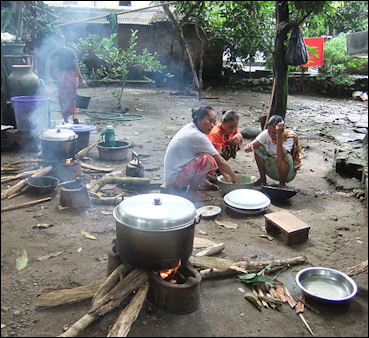FOOD IN THE DEVELOPING WORLD
cooking in Lombok, Indonesia The poor have traditionally gotten most of their calories from grain while the rich and middle class have gotten theirs from meat.
Grain is usually baked into bread and boiled into a porridge-like gruel. Most meals consist of porridge made out corn, cassava or millet, or a stew made with potatoes. Rice and beans are too expensive for many people to afford and a pizza costs more than many people make in a week.
Many people have only one on two meals a day. A typical breakfast is made up of porridge. A typical lunch consists of goat stew with tomatoes, okra, onions and green beans, or perhaps potatoes and smoked fish and tea. Sometimes there is nothing to eat for dinner.
In Latin America some villagers wake up early and eat frequently. Most meals consist of hand-made corn tortillas, cooked on a sheet of metal placed over the fire and dipped in a bean soup. Protein is in short supply and usually comes from beans. Whenever meat available it is made into a stew.
Many people suffer from malnutrition because they eat three bowls of rice a day, or something similar, and little else. Good nutrition comes from eating a wide variety of foods.
Cooking oil is vital for cooking meat, vegetables and eggs and is used with flour or rice to cook a variety of foods.
Cabbage is valued because it stays good a long time even when it is not refrigerated. Honey is a laxative and is often consumed to ease soar throats and hoarseness.
The practice of earth-eating, or geophagy, is widespread in Latin America and Africa. The clay is usually shaped into flat square tablets and decorated with religious symbols. Geographers from the University of Michigan have discovered that clay is taken mainly by pregnant women to relieve morning sickness and ensure a safe delivery. With little nutritional value the benefits of the tablets are seen essentially as an act off faith. When the geographers asked a women if they did her any good. "Of course," she replied. "I have eight children!" [National Geographic Geographica, December 1989].
Food Preparation and Cooking
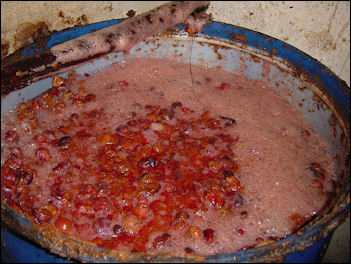
Komina serbai Cooking is often done outdoors in a courtyard, over a fire, on a piece of sheet metal supported by clay supports. Food is usually prepared in aluminum pots and passed around. Men help themselves first and then boys take their turn. Women and girls get what remains, but there is usually plenty to go around.
Villagers grow their own cabbage, potatoes and vegetables. Grain is either grown or purchased at the market, crushed in basin-size mortars with baseball bat-size pestles. What little money a family earns from selling surplus food is spent on items like food, tea, sugar, tools and kitchen utensils. Things like chocolate and coffee are luxuries beyond the reach of most people.
Women generally do all the cooking. Items found in the kitchen included aluminum cooking pot, water storage vessels, and small bowls for salt and snacks. There are ladles and large bowls for eating and serving food; mortars and pestles for grinding up food; and saucepans, baking pans and frying pans.
Peace Corps volunteers have taught people how to make more efficient cooking stoves with a circular piece of metal and some rocks that helps trap heat instead of letting it escape.
Meat and Protein in the Developing World
Meat is a luxury. People often prefer to purchase live animals which they kill themselves or get their meat from animals killed in front of them. That way they know the meat is fresh and less likely to carry some disease. Places where meat is sold often lack refrigerators.

Killing an animal for a Muslim holiday in west AfricaThe necessary amounts of all 20 amino acids can be obtained by large amount of nitrogenous foods such as beans and nuts but these amino acids are available in a more concentrated form in meat. UHT-treated soy milk is and ideal protein source for people who can not afford meat. It keeps for six months and is easy and cheap to produce.
Meat consumption in the developing world increased from around 20 pounds per person a year in 1961 to around 60 pounds in 1998. In contrast, North Americans eat 260 pounds of meat a year. In the developing world fish is often the main source of protein although goats, pigs, sheep and cattle are also raised. Wild animals such as monkeys are often killed for meat.
Eating Insects to Save the Planet
Reporting from Wageningen, Netherlands, Ivana Sekularac of Reuters wrote: “All you need to do to save the rainforest, improve your diet, better your health, cut global carbon emissions and slash your food budget is eat bugs. Mealworm quiche, grasshopper springrolls and cuisine made from other creepy crawlies is the answer to the global food crisis, shrinking land and water resources and climate-changing carbon emissions, Dutch scientist Arnold van Huis says. [Source: Ivana Sekularac, Reuters, January 20, 2011]
The professor at Wageningen University in the Netherlands said insects have more protein than cattle per bite, cost less to raise, consume less water and don't have much of a carbon footprint. He even has plans for a cookbook to make bug food a more appetizing prospect for mature palates. "Children don't have a problem with eating insects, but adults with developed eating habits do, and only tasting and experience can make them change their minds," Van Huis said. "The problem is psychological."
Van Huis has organized lectures, food tastings, and cookery classes with a master chef who demonstrates how to prepare a range of recipes using bugs, worms and grasshoppers, all bred -- or raised -- at a Dutch insect farm for consumption. To attract more insect-eaters, Van Huis and his team of scientists at Wageningen have worked with a local cooking school to produce a cookbook and suitable recipes.
Chef Henk van Gurp, who created recipes for mealworm quiche and chocolate pralines with buffalo worms, sees no reason to disguise the ingredients, and sprinkles mealworms on top of the quiche filling and onto the chocolate buffalo worms as protein. "I try to make my food in a way that people can see what they eat," he told Reuters. "Once international leading chefs begin preparing this food, others will follow."
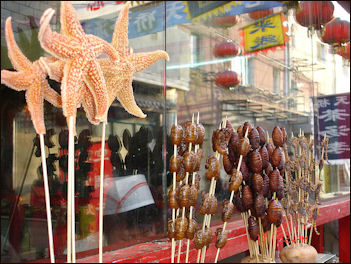
Scorpions, bugs and starfish for sale in Beijing Grasshoppers are considered a tasty snack in Asian countries including Thailand and Vietnam, but are not a feature on the Dutch menu. Van Huis says Europeans should consider insects an alternative source of protein because they can contain up 90 percent protein, compared with 40-70 percent for beef. "Meat consumption is expected to double from 2000 to 2050. We are already using 70 percent of our agricultural land for livestock and we cannot afford to spare more," he said. Plus raising cattle is responsible for 18 percent of greenhouse gases emissions.
Insects are already bred as food for birds, lizards and monkeys at the Callis family's farm near the university, and now the owners see a chance to sell bugs for human consumption. "It is good food, of high nutritional value, and very healthy for elderly people," said Margot Callis. Though she cannot eat insects herself because she is allergic to them.
Duyugu Tatar, a 24-year-old IT consultant who attended a recent lecture and food-tasting at the university, was less effusive about the mealworm quiche. "The taste was not that awful, but the idea of eating them horrified me. It was crispy. The taste was not like normal food. Not like meat, vegetable, or fruit. Maybe something like cornflakes," she said. "It took a lot of courage to eat it, I usually smash them (insects) when I see them. I am not used to eating them. I don't know if I would eat it again."
Alcoholic Drinks, Non-Alcoholic Drinks and Smoking
Many villagers love to drink. The beverages of choice vary from place to place. Many villages make their own brews.
Villagers sometimes sprinkle alcoholic drinks in churches to speed their prayers to heaven and say a drunken man is close to god. Not surprisingly villages and towns are often filled with a lot of passed out, slobbering drunks.
Tea is quite common. Coffee is regarded as a luxury. Coca-Cola is found almost everywhere these days. For infants mothers milk is preferred because it is safe. Formula is often mixed with dirty water.

Refreshing palm wine Smoking is very popular. Most village men like to smoke, and they would probably smoke more if they could afford it. Cigarettes are offered as a friendly greeting and given as wedding gifts. Vendors often sell one cigarette at a time; they are surprised if somebody can actually afford an entire pack. Taxes on cigarettes is major source of revenue for the government.
Eight-four percent of smokers live in developing or transitional economies. The statistics they would probably be even higher if more people could afford to smoke. It is estimated that 7 million people in the developing world will die a year of smoking-related illnesses in the developing world by 2030.
Village Clothes
Many people wear clothes that have been made by a family member and either go barefoot or wear flip flops or sandals. Many villagers wear their best clothes to the market.
Women in rural areas are known for their colorful clothes. They wear colorful shawls, embroidered skirts, headdresses and blouses. Often times each village has its own distinct cloth pattern.
Women wear lots of gold and silver bracelets and jewelry, which of represents the family's wealth. Gold is often bought as a hedge against inflation.
Lots of boys have buzz cuts. Men often identify their religion or ethnic group or clan with their traditional headgear. Women do the same with traditional garments that they can wear everyday or for special occasions.
Weaving and Spinning
Weaving is the interlocking at right angles of two sets of fibers to make cloth or a similar material. Spinning is the process by which fibers are drawn and twisted into string, yarn or thread. These tasks have traditionally been done at home by women with looms and spinning devices. The advantage with working at home is that women could work and care for their children at the same time and do weaving and spinning when they are not doing other chores
To make yarn the old-fashion way: 1) After a sheep is sheared the wool fibers are cleaned and straightened by carding with a toothed card (a sort of brush with stiff bristles). 2) The wool is then rolled between two cards to produce a thin fiber-like piece of wool called a sliver. 3) The sliver is placed on a spike called a distaff. 4) A strand of wool is then pulled off and a weight known as whorl is attached to it. 5) The strand is twisted into a thread by spinning it with the thumb and forefinger. Since each thread is made this way, you can how time consuming it must have been to make a piece of cloth.
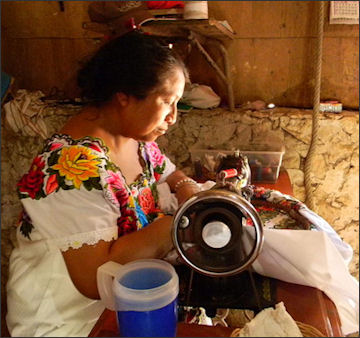
Mayan women making souvenirsTo make cloth the old-fashion way: 1) Threads are placed on a warp-weighted loom. Warps are the downward hanging threads on a loom, and they are set up so that every other thread faces forward and the others are in the back. 2) A weft (horizontal thread) is then taken in between the forward and backward row of warps. 3) Before the weft is threaded through in the other direction, the position of the warps is changed with something called a heddle rod. This simple tool reverses the warps so that the row in the front is now in the rear, and visa versa. In this way the threads are woven in a cross stitch manner that holds them together and creates cloth. The cloth in turn is all kinds of things.
The women sometimes use natural dies. Red is made with madder or kermes (an insect found in kermes oak); yellow with wild chamomile, saffron, vine leaves and the rinds of pomegranates; black from acorns; and blue from plants with indigo.
Natural dyes produce richer and more natural colors. The depth of color can be controlled by the type of water — rain, river or spring — used. Plant dyes though are notoriously unpredictable. They are affected by weather conditions, soil and when they are harvested. They have mostly been replaced by chemical dyes.
Western and Recycled Clothes
Western fashions are also very big. Baggy shorts, blue jeans, skateboards, backwards baseball caps and leather jackets are all popular with kids.
Most people buy their clothes used. There is a big market for recycled clothes from the developed world. Often a large proportion of the clothes originate from thrift shops and Salvation Army stores in the United States.
In some cases huge bales of used clothes are sent first to Japan. Retailers there pick through the clothes in hanger-size warehouses, and take the best stuff, wash it and sell it at their stores. What remains is bailed up and shipped to South Korea, where the same process is repeated, with the least wanted items shipped to the developing world, where they end up in stalls in markets.
Water and Daily Life
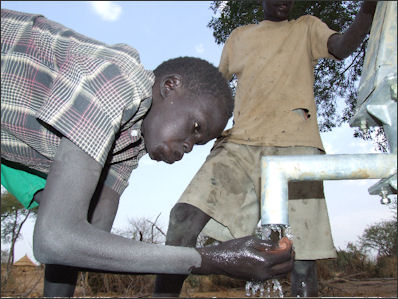
Only 10 percent of water worldwide is consumed for personal uses such as drinking, bathing and washing clothes and dishes. Each person needs about 48 liters (13 gallons of water) a day for drinking, cooking and sanitation. Even so, a sixth of world’s population gets by on less than that. Americans use an average of 400 liters of water per person per day. A lot this is water used for thing like irrigation and industry not just taking showers, washing cars and flushing toilets.
Most homes in the developing world don't have running water or toilets. In rural areas, water is often fetched and carried from wells and streams or even ponds. Urban poor get their water from community spigots. The water is often of dubious quality and dirty enough to make those who drink it get sick.
Rural people are very good at bathing in streams and rivers without removing their clothes. In past villagers had to walk long distances to wells. Today, deep-boring machinery introduced by aid workers has enabled villages to have their own wells.
One new water container design that seems to hold promise in the developing world is a wheel-like donut-shaped polyethylene water container that can hold 50 to 70 liters of water and can be easily pulled by a child with a string put through the hole of the container.
Beauty, Hygiene and Cleanliness in the Developing World
Beauty is arguably less prized in the developing world than in the developed world. A good bride in many countries is considered to be a woman who can "cook, look after her husband and give him sons." That is the opinion of some any way. The owner of a successful Chinese cosmetic company told AP, “All women want to look pretty, and poorer women want it even more. With good education or rich parents, appearance is what they count on to move up the social ladder.”
Avon ladies are found pretty much everywhere. When village women have some free time they like to do things like meet at a friend’s house and try cosmetics and fingernail polish.
Cleanliness is virtue inside people’s homes anyway. People often litter in public and streets may be beat up and full of trash but people keep their homes clean. Even the inside of shacks and slums are often is spotless. Often times the only way a poor family surrounded by filth can express their self worth is through their clean clothes, bodies and home. Children usually wash themselves before school with rough soap and well water in a pail. Mothers spend a lot of time making sure that their house is tidy and clean. Floors are mopped on daily basis and walls are scrubbed weekly. The condition of a house is a reflection on the family and especially the mother.
Village Bathrooms and Toilets
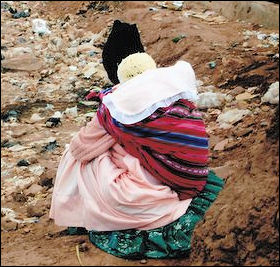
poncho toilet More than 2.6 billion people around the world don't have access to safe sanitation. Instead of using toilets connected to sewer lines, most leave their waste on the ground or in a ditch or pit. The result is unsightly, unsanitary and contributes to illness. Some 1.5 million children die each year from diarrhea-related diseases, often connected to poor sanitation. Many development experts believe most of these deaths could be prevented with proper sanitation, safe drinking water and improved hygiene.
According to a United Nations report, half the world's people don't have access to toilet or a clean latrine People often relieve themselves in the bushes or in a field. Only 30 percent of the world uses toilet paper. Alternatives include hands, water, sand, small rocks, mud, leaves, rope and seaweed.
Toilets can be very wasteful. The water from one flush of a toilet is equal to what an average person uses each day in the 30 world’s poorest countries.
See Separate Article TOILETS AND SANITATION IN THE DEVELOPING WORLD factsanddetails.com
Image Sources: Wikimedia Commons
Text Sources: New York Times, Washington Post, Los Angeles Times, Times of London, Yomiuri Shimbun, The Guardian, National Geographic, The New Yorker, Time, Newsweek, Reuters, AP, Lonely Planet Guides, Compton’s Encyclopedia and various books and other publications.
Last updated January 2012

